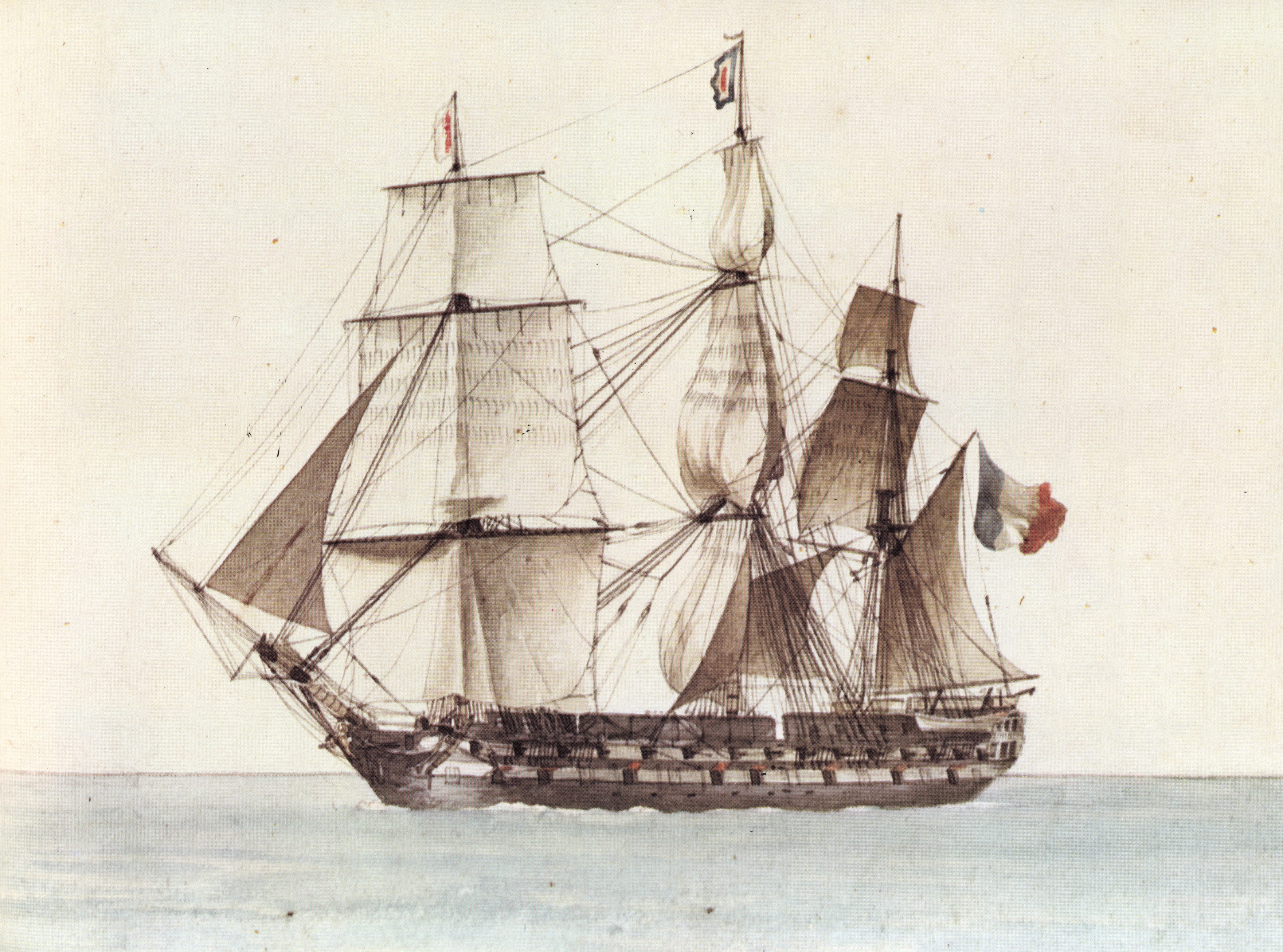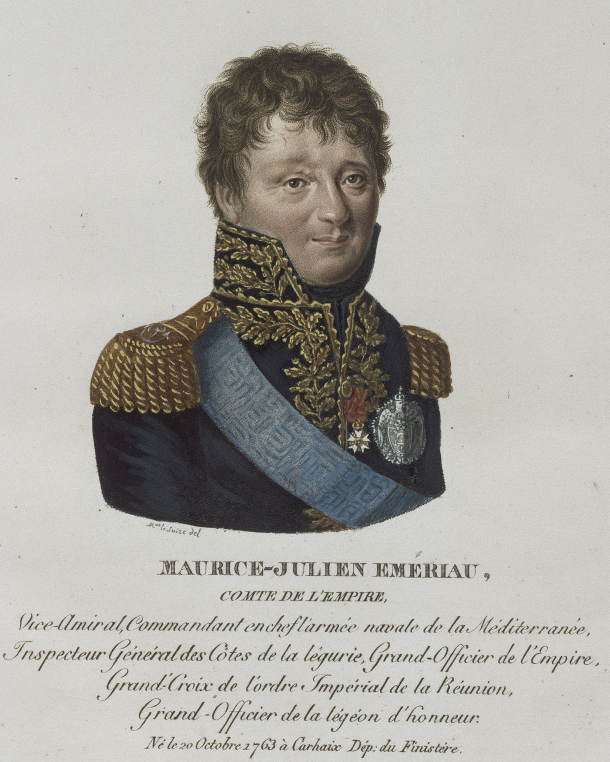|
French Ship Borée (1805)
''Borée'' was a 74-gun ship of the line of the French Navy. Design and construction Designed based on plans by Jacques-Noël Sané, and updated by Maillot, she and her sister ( ''Pluton'') were the prototypes of a new variant of the ''Téméraire'' class designed to have a smaller draught, allowing the production of ships of the line in the shallow harbour of Antwerp. The construction of ''Borée'' was delayed due to a lack of timber, causing her completion date to fall behind that of , a sistership then under construction. ''Borée'' was retro-fitted with improvements introduced on ''Pluton''. Career In May 1805, ''Borée'' was commissioned and Captain Louis-André Senez took command on 29 August.Quintin, p.341-342 She was part of the Mediterranean squadron under Vice-Admiral Ganteaume, in Toulon. From February to April 1808, ''Borée'' took part in Ganteaume's expedition to Corfu. In April 1809, she took part in the escort of a convoy to Barcelona, in a division ... [...More Info...] [...Related Items...] OR: [Wikipedia] [Google] [Baidu] |
Ships Of The Line Of The French Navy
A ship is a large watercraft that travels the world's oceans and other sufficiently deep waterways, carrying cargo or passengers, or in support of specialized missions, such as defense, research, and fishing. Ships are generally distinguished from boats, based on size, shape, load capacity, and purpose. Ships have supported exploration, trade, warfare, migration, colonization, and science. After the 15th century, new crops that had come from and to the Americas via the European seafarers significantly contributed to world population growth. Ship transport is responsible for the largest portion of world commerce. The word ''ship'' has meant, depending on the era and the context, either just a large vessel or specifically a ship-rigged sailing ship with three or more masts, each of which is square-rigged. As of 2016, there were more than 49,000 merchant ships, totaling almost 1.8 billion dead weight tons. Of these 28% were oil tankers, 43% were bulk carriers, and 13% were co ... [...More Info...] [...Related Items...] OR: [Wikipedia] [Google] [Baidu] |
Action Of 5 November 1813
The action of 5 November 1813 was a brief naval clash during the Napoleonic Wars, between part of the British Mediterranean Fleet led by Vice-Admiral Edward Pellew, 1st Viscount Exmouth, Sir Edward Pellew, and a French force under Rear-Admiral Julien Cosmao, Julien Cosmao-Kerjulien. The engagement took place outside the French port of Toulon. The clash occurred when a French fleet under Vice-Admiral Maxime Julien Émeriau de Beauverger took advantage of a favourable wind and the temporary absence of the British blockading force, to leave port to carry out exercises. Émeriau abandoned the exercises when the wind changed, but while returning to port his rear came under attack from the recently returned British inshore squadron. The British attack was reinforced by newly arrived ships from the main fleet, but the French were able to escape into Toulon after exchanging cannon fire with the British. Casualties on both sides were light. Background The French Mediterranean Fleet had be ... [...More Info...] [...Related Items...] OR: [Wikipedia] [Google] [Baidu] |
Maxime Julien Émeriau De Beauverger
Maxime Julien Émeriau de Beauverger (20 October 1762 in Carhaix – 2 February 1845 in Toulon) was a French Navy officer and admiral. Biography American War of Independence Emeriau joined the Navy in 1776, just before the outbreak of the American War of Independence, taking service on the fluyt ''Sylphe''. He took part in the Battle of Ushant on the ''Intrépide'' in 1778. He was then transferred on the ''Diadème'', in Admiral d'Estaing's fleet, taking part in the Battle of Grenada, where he was wounded, and in the Siege of Savannah, where one of his eyes was wounded. Emeriau served under Lamotte-Picquet during the Battle of Martinique. After rising to ''lieutenant de frégate'', he took part in the campaigns of Admiral de Grasse, serving aboard a number of ships. He took part in the Battle of St. Kitts and in the Battle of the Saintes, where he was twice wounded. After the Treaty of Paris, Emeriau sailed with the commerce. In 1786, Emeriau returned to the Navy ... [...More Info...] [...Related Items...] OR: [Wikipedia] [Google] [Baidu] |
Jean-Michel Mahé
Jean-Michel Mahé (12 October 1776, in Carhaix – 20 February 1833, in Nantes) was a French Navy officer and captain. Career Mahé started his career in the merchant Navy in 1789, and became an Midshipman in the Navy on 16 April 1794. He served on the fluyt ''Duras'' before embarking on '' Montagne'', flagship of Villaret-Joyeuse on which he took part in the Glorious First of June.Quintin, p. 254 From October 1794, he served on the frigate '' Fraternité'', on which he took part in the Battle of Groix on 23 June 1795 under Lieutenant Florinville. He then served on the brig-aviso ''Impatient'', the lugger ''Titus'', and the felucca ''Fort''. On 7 July 1797, he was promoted to Ensign and given command of the schooner ''Gentille'', escorting convoys off Bretagne. He served twice on the corvette ''Réolaise'', captained the gunboat ''Caroline'' in the summer of 1800, and returned on ''Impatient'' from October 1800 to January 1801. In February, he embarked on the frigate '' Chiff ... [...More Info...] [...Related Items...] OR: [Wikipedia] [Google] [Baidu] |
Sète
Sète (; oc, Seta, ), also historically spelt ''Cette'' (official until 1928) and ''Sette'', is a commune in the Hérault department, in the region of Occitania, southern France. Its inhabitants are called ''Sétois'' (male) and ''Sétoises'' (female) in French, "Setòris" and "Setòria" in Occitan. Known as the ''Venice of Languedoc'' and the ''singular island'' (in Paul Valéry's words), it is a port and a seaside resort on the Mediterranean with its own very strong cultural identity, traditions, cuisine and dialect. It is the hometown of such artists as Paul Valéry, Jean Vilar, Georges Brassens, Hervé Di Rosa, Manitas de Plata, and Robert Combas. Since 2001, François Commeinhes is the mayor of the city. Geography Built upon and around Mont St Clair, Sète is situated on the south-eastern end of the Étang de Thau, an enclosed salt water lake used primarily for oyster and mussel fields. To its other side lies the Mediterranean, and the town has a network of canals ... [...More Info...] [...Related Items...] OR: [Wikipedia] [Google] [Baidu] |
Battle Of Maguelone
The Battle of Maguelone was a minor naval action that occurred in late October 1809, during the Peninsular War, between the escort of a French convoy, comprising three ships of the line and two frigates, and a six-ship squadron of the Royal Navy. In a running battle, the French covered the retreat of the convoy and attempted to escape by sailing in shallow waters close to the shore of Maguelone. After two of the ships of the line ran aground, their crews evacuated them and scuttled them by fire after removing valuable equipment, including the artillery. The remaining ship and frigates made good their escape to Toulon. A British cutting-out party attacked the convoy in Baie des Roses on 1 November, destroying most of it and capturing three ships. Context On 21 October 1809, a squadron of the French Navy under Rear-Admiral François-André Baudin left Toulon, escorting a convoy bound for Barcelona. On 23 October, off Cape Saint Sebastian, the squadron detected five sails in t ... [...More Info...] [...Related Items...] OR: [Wikipedia] [Google] [Baidu] |
HMS Leviathan (1790)
HMS ''Leviathan'' was a 74-gun third-rate ship of the line of the British Royal Navy, launched on 9 October 1790. Service history At the Battle of Trafalgar under Henry William Bayntun, she was near the front of the windward column led by Admiral Lord Nelson aboard his flagship, , and captured the Spanish ship . A flag said to have been flown by the ''Leviathan'' at Trafalgar is to be sold at auction by Arthur Cory in March 2016 - Bayntun is thought to have given it to his friend the Duke of Clarence (later William IV), who then gave it to Arthur Cory's direct ancestor Nicholas Cory, a senior officer on William's royal yacht , in thanks for helping the yacht win a race and a bet. ''Leviathan'', , , , and shared in the proceeds of the capture on 10 September 1797 of the ''Tordenskiold''. In 1809, she took part in the Battle of Maguelone. On 27 June 1812, ''Leviathan'', , and attacked an 18-strong French convoy at Laigueglia and Alassio in Liguria, northern Italy. Fate ... [...More Info...] [...Related Items...] OR: [Wikipedia] [Google] [Baidu] |
French Frigate Pauline (1807)
''Pauline'' was a 44-gun of the French Navy. Service history On 27 February 1809, along , she captured the 32-gun . . Accessed 4 April 2016 In October 1809, she sailed from to escort a convoy bound for . Chased by a British squadron under Admiral Collingwood during the , and sailing with , ... [...More Info...] [...Related Items...] OR: [Wikipedia] [Google] [Baidu] |
Roses, Girona
Roses (; es, Rosas, link=no, ) is a municipality in the comarques of Catalonia, ''comarca'' of the Alt Empordà, located on the Costa Brava, Catalonia, Spain. Roses is the site of the former bishopric of Rotdon, now a Latin Catholic titular see. It is situated on the coast at the northern end of the Gulf of Roses, and is an important fishing port and tourist centre. The C-260 road links the town with Figueres. The GR 92 long distance footpath, which roughly follows the length of the Mediterranean coast of Spain, has a staging point at Roses. Stage 3 links northwards to Cadaqués, a distance of , whilst stage 4 links southwards to the ''El Cortalet'' pond in the Parc Natural dels Aiguamolls de l'Empordà, a distance of . History Early history The origins of Roses are disputed. According to classical sources, it was founded in the 8th century BC by Greek colonists from Rhodes and was called Rhode ( grc, Ῥόδη). It seems more probable that it was founded in the 5th century ... [...More Info...] [...Related Items...] OR: [Wikipedia] [Google] [Baidu] |





